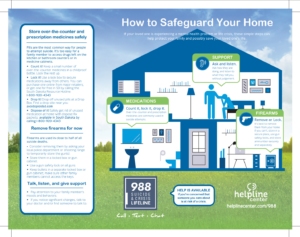Means Safety
What is Means Safety?
In a suicide crisis, the length of time someone seriously contemplates suicide tends to be short-lived. Reducing access by secure storage or “means safety” refers to making an effort to limit or eliminate the ability for a person at risk of suicide to access the means for their suicide plan. If suicidal behaviors are detected early and access to firearms, medications or other substances and objects can be restricted during the time of crisis, a life can be saved.
From 2013-2022, 49% of suicide deaths in South Dakota were firearm related with another 11% of suicide deaths from poisoning. From 2019 -2022, 76% of Veteran Suicides in South Dakota were the result of self-inflicted gunshot wounds. (Source: SD DOH)
Secure storage practices play a vital role in preventing use of lethal means for suicides. Secure storage practices include having firearms unloaded, locked and in a separate place from ammunition.
Video by: The Suicide Prevention Resource Center
What can reduce risk?
- Safeguard Your Home brochure
- Restricting access to pesticides, alcohol, and other substances
- Safely storing over-the-counter and prescription medicines and properly disposing of unused medications
- Change packaging of medications to bubble packs
- Using a gun safety lock on all firearms
- Paying attention to family member’s moods and behaviors
- Interventions
- Safety Planning Guide
- Safety Planning Training
- Call, Text or Chat 988 24/7 for assistance for yourself or loved one
Resources
Available 24/7 via call, text and chat for any behavioral health need. Press 1 for Veterans. For more information visit https://988lifeline.org/chat/
- Veterans Crisis Line (linked to https://www.veteranscrisisline.net/ )
- 988 Press 1
- Means Safety
- Mental Health First Aid- Adult, Teen, Youth, First Responders & Higher Education
- QPR (Question, Persuade, Refer)
- NAMI Ending the Silence
- ASIST (Applied Suicide Intervention Skills Training)
Means Safety resources are available through The Helpline Center. Order printed materials from the Helpline Center’s website such as the How to Safeguard Your Home brochure, Tips for Ranges, Tips for Firearm Retailers, and Tips for Family and Friends. A one hour Means Safety Training is also available by The Helpline Center that provides specific and practical advice on how to dispose of, or lock up firearms and substances that may be used in a suicide attempt.


